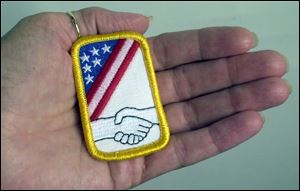
Labor leaders want to instill sense of history in youth
9/3/2001
Girl Scouts of the Maumee Valley are joining other councils in the United States in offering the chance to earn labor patches.
From patches offered by the Girl Scouts to prize-winning history projects, young people are learning more about the U.S. labor movement.
And if union leaders like Toledo's Bill Lichtenwald have their way, it's just the beginning.
Schools have long shunned the formal instruction in labor history sought by union leaders, but labor groups such as Mr. Lichtenwald's Teamsters Local 20 are renewing a push to promote labor education. They see it as a chance for children to learn about an important chapter of U.S. history and to reduce stereotypes and negative misconceptions that make it difficult for unions to organize young workers.
Critics worry that the presentations could be one-sided and serve as a recruitment tool for unions.
Still, there is evidence that unions are making headway:
“A lot of the kids today don't know how we got here and the historical struggles workers went through at the early part of the century,” said Mr. Lichtenwald, president of the 8,000-member Teamsters local. “Baby boomers were brought up by parents who could tell them about what things were like in the '30s. But children today don't have that. They haven't been brought up in a union atmosphere. A lot of Gen Xers not only don't have respect for unions but are anti-union.”
Local 20's plans are still being formulated, but leaders have talked about giving high school students a chance to witness mock arbitration hearings.
“My concern would be, `Are students getting a balanced view?'” said Dan Yager, of the pro-business Labor Policy Association in Washington. “If one particular interest group is directing this educational effort, it's not going to be an unbiased viewpoint.”
Labor education programs are bound to encounter opposition, but are worthwhile nonetheless, said Lloyd Mahaffey, director of the UAW's Toledo-based western Ohio region.
“Children need to know about labor unions and the contributions they've made to the nation, and how we've helped create a middle class,” he said.
Efforts to introduce a labor curriculum into high schools have met with limited success. The Illinois Labor History Society six years ago drew up a sample curriculum, posted it on the Internet, and invited teachers to make use of it. But there is little evidence that has happened, conceded Leslie Orear, society president. “The problem, he said, “is that schools are mostly trying to teach the basics and have no time to fool around with enriching their programs.”
Mr. Orear, who is 90, argues that such programs can be beneficial. “Our organization was formed to remind people of the state of Illinois that there is history beyond that of great leaders and institutions and political figures. There is a history of working people. It is the history of you, your great-grandfather, your great-grandmother, of the people who came from the old country and built this country with their hands.”
There are signs that labor education is creeping into schools through programs such as the student history projects done in connection with National History week, he said.
Girl Scouts seeking the labor patch are asked to complete six activities from a list of 12. Possibilities include developing a timeline of significant events in labor history, leading a troop discussion about issues facing working people, and comparing the rights and responsibilities of union workers with those not covered by collective bargaining agreements.
The Girl Scouts locally offer hundreds of projects for members to earn patches and look forward to adding the labor patch, said spokeswoman Donna Kolbow.